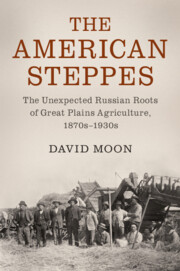Book contents
- The American Steppes
- Studies in Environment and History
- The American Steppes
- Copyright page
- Dedication
- Epigraph
- Contents
- Figures, Maps, and Tables
- Preface
- Acknowledgements
- Notes on the Text
- Dramatis Personae
- Abbreviations
- Maps
- Introduction
- Part I Contexts
- Part II Transfers
- Chapter 4 Wheat
- Chapter 5 Soil Science I
- Chapter 6 Soil Science II
- Chapter 7 Shelterbelts I
- Chapter 8 Shelterbelts II
- Chapter 9 Tumbleweed
- Conclusion
- Archival Collections Cited
- Index
Chapter 5 - Soil Science I
from Part II - Transfers
Published online by Cambridge University Press: 23 March 2020
- The American Steppes
- Studies in Environment and History
- The American Steppes
- Copyright page
- Dedication
- Epigraph
- Contents
- Figures, Maps, and Tables
- Preface
- Acknowledgements
- Notes on the Text
- Dramatis Personae
- Abbreviations
- Maps
- Introduction
- Part I Contexts
- Part II Transfers
- Chapter 4 Wheat
- Chapter 5 Soil Science I
- Chapter 6 Soil Science II
- Chapter 7 Shelterbelts I
- Chapter 8 Shelterbelts II
- Chapter 9 Tumbleweed
- Conclusion
- Archival Collections Cited
- Index
Summary
In the 1870s and 1880s, Russian soil scientists under Vasilii Dokuchaev devised an innovative science of soils. They understood soils as natural-historical bodies that had formed in the environments in which they existed. The innovation, which was based on field work in the steppes, allowed the mapping of large soil groups over extensive areas. It could be applied around the world and suggested that the soils of the Great Plains were similar to those of the steppes. The US government soil survey that began in 1899 under the direction of Milton Whitney was largely limited to a physical and geological understanding of soils. Whitney was hostile to the Russian innovation and tried to prevent its spread among American scientists.
- Type
- Chapter
- Information
- The American SteppesThe Unexpected Russian Roots of Great Plains Agriculture, 1870s–1930s, pp. 188 - 225Publisher: Cambridge University PressPrint publication year: 2020

